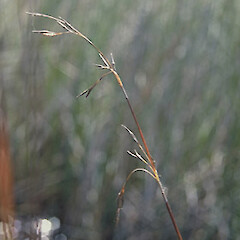Schoenus carsei
Synonyms
None
Family
Cyperaceae
Flora category
Vascular – Native
Endemic taxon
No
Endemic genus
No
Endemic family
No
Structural class
Sedges
Chromosome number
2n = c.60
Current conservation status
The conservation status of all known New Zealand vascular plant taxa at the rank of species and below were reassessed in 2017 using the New Zealand Threat Classification System (NZTCS) – more information about this can be found on the NZTCS website. This report includes a statistical summary and brief notes on changes since 2012 and replaces all previous NZTCS lists for vascular plants.
Please note, threat classifications are often suggested by authors when publications fall between NZTCS assessment periods – an interim threat classification status has not been assessed by the NZTCS panel.
- Conservation status of New Zealand indigenous vascular plants, 2017 . 2018. Peter J. de Lange, Jeremy R. Rolfe, John W. Barkla, Shannel P. Courtney, Paul D. Champion, Leon R. Perrie, Sarah M. Beadel, Kerry A. Ford, Ilse Breitwieser, Ines Schönberger, Rowan Hindmarsh-Walls, Peter B. Heenan and Kate Ladley. Department of Conservation. Source: NZTCS and licensed by DOC for reuse under the Creative Commons Attribution 4.0 International licence.
2017 | Threatened – Nationally Critical | Qualifiers: DP, RR, TO
Previous conservation statuses
2012 | Threatened – Nationally Endangered | Qualifiers: RR, TO
2009 | Threatened – Nationally Endangered | Qualifiers: DP, RR, SO, Sp
2004 | Gradual Decline
Distribution
Indigenous. Present In Australia. In New Zealand confined to the North Island where it is now known from North Cape to Hinehopu mire in the Rotorua Lakes district. It formerly grew at Ngaere Swamp (Taranaki).
Habitat
Coastal, lowland to montane. Usually in moderately fertile to acid wetlands. Often on the margins of burn pools or other slow moving water channels, where it often grows in association with Baumea rubiginosa, B. teretifolia, Tetraria capillaris and Empodisma minus. Occasionally associated with the margins of small ephemeral dune ponds.
Wetland plant indicator status rating
Information derived from the revised national wetland plant list prepared to assist councils in delineating and monitoring wetlands (Clarkson et al., 2021 Manaaki Whenua – Landcare Research Contract Report LC3975 for Hawke’s Bay Regional Council). The national plant list categorises plants by the extent to which they are found in wetlands and not ‘drylands’. The indicator status ratings are OBL (obligate wetland), FACW (facultative wetland), FAC (facultative), FACU (facultative upland), and UPL (obligate upland). If you have suggestions for the Wetland Indicator Status Rating, please contact: [Enable JavaScript to view protected content]
OBL: Obligate Wetland
Almost always is a hydrophyte, rarely in uplands (non-wetlands).
Detailed description
Stout rush-like sedge of mid-acid to acidic peat bogs and mires. Rhizomes short, 3 mm diam., covered in closely appressed red-purple bracts. Culms 600–900 mm, c. 1 mm diam., densely tufted light green, grass-green to orange-green. Leaves reduced to brown, mucronate sheaths, the uppermost mucro often elongating greatly, mouth of sheath not ciliate. Panicle 80–150–(220) mm long, very slender, fascicles distant, of 3–4 branchlets, subtended by short sheath similar to those of culm base; branchlets filiform, flexuous, simple or branched again. Spikelets single at tips of branchlets, 7–10 mm, 2-flowered, very narrow, compressed, linear lanceolate, grey-brown. Glumes 5–7, imbricating, lanceolate, acute, hyaline except near midrib, margins not ciliate, 3–4 lower glumes, upper most glume empty. Hypogynous bristles 0–(3), minute. Stamens 3. Style-branches 3. Nut 2 × 1 mm, oblong-ovoid, obtuse, smooth, white.
Similar taxa
Frequently confused with Netrostylis capillaris (F.Muell.) R.L.Barrett, J.J.Bruhl et K.L.Wilson, a similar rush-like plant with very fine yellow-green culms, which often grows in association with S. carsei. From that genus and species, S. carsei differs by its wider culms, larger panciles bearing more numerous flowers and by the rhacilla of the spikelet flexuous (wavy), short between sterile nodes and elongated between the fertile nodes.
Flowering
(September)–October–January
Fruiting
December–May
Propagation technique
Can be grown from the division of whole plants and probably from fresh seed. Dislikes root disturbance and requires permanently waterlogged substrates
Threats
Threatened by wetland drainage, eutrophication, modification and the spread of naturalised wetland weeds. There are few recent records, and the majority of these come form the Whangamarino and Opuatia wetlands in the Huntly Basin.
Etymology
schoenus: Rush
Where To Buy
Not commercially available.
Attribution
Fact Sheet by P.J. de Lange (28 July 2005). Description adapted from Moore and Edgar (1970).
References and further reading
Gardner RO. 1998. Schoenus carsei and Tetraria capillaris. Auckland Botanical Society Journal 53: 38–40.
Gardner RO. 1998. Schoenus carsei revisited. Auckland Botanical Society Journal 53: 56–57.
Moore LB, Edgar E. 1970. Flora of New Zealand, Volume II. Indigenous Tracheophyta: Monocotyledones except Gramineae. Government Printer, Wellington, NZ. 354 p.
NZPCN Fact Sheet citation
Please cite as: de Lange, P.J. (Year at time of access): Schoenus carsei Fact Sheet (content continuously updated). New Zealand Plant Conservation Network. https://www.nzpcn.org.nz/flora/species/schoenus-carsei/ (Date website was queried)






